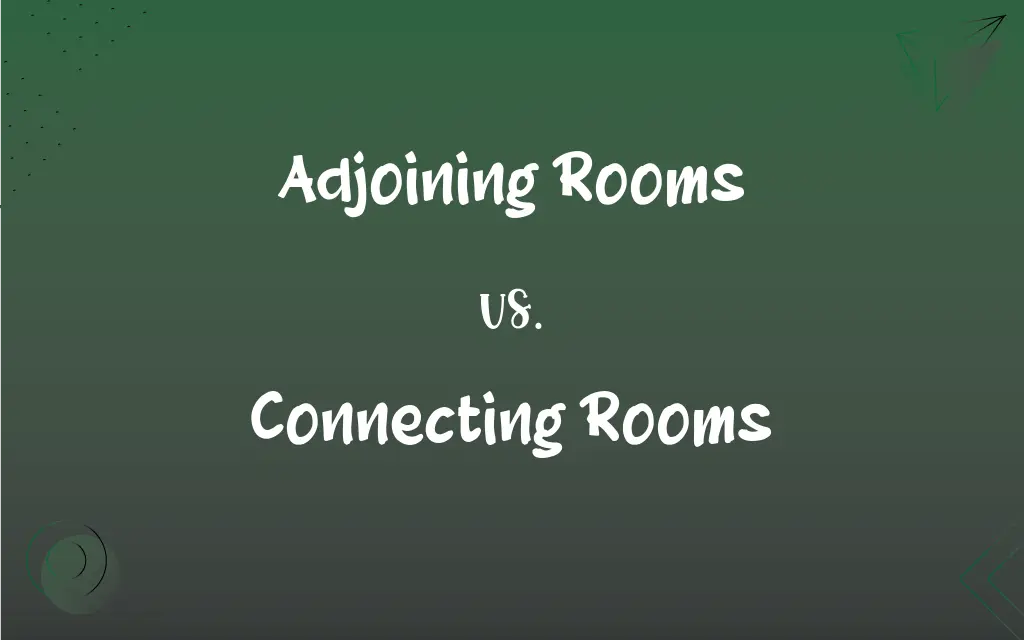Adjoining Rooms vs. Connecting Rooms: What's the Difference?
Edited by Aimie Carlson || By Harlon Moss || Published on February 25, 2024
Adjoining Rooms are two hotel rooms next to each other without a door in between. Connecting Rooms are two hotel rooms linked by an internal door.

Key Differences
Adjoining rooms in hotels are two separate rooms located next to each other, typically sharing a common wall. They do not have an internal door connecting them. Connecting rooms, however, are two rooms that have a door inside, allowing guests to move freely between them without exiting into the public hallway.
Adjoining rooms are ideal for groups or families who need separate spaces but want to stay close, without the need for direct access between the rooms. Connecting rooms provide the convenience of easy access, making them suitable for families with children or groups who want to maintain a sense of privacy while still being connected.
When booking adjoining rooms, guests will have two distinct and private spaces, but they'll need to use the main hallway to move between rooms. In contrast, with connecting rooms, guests can maintain privacy and security while enjoying the flexibility of a larger combined space.
Adjoining rooms often appeal to travelers who require close proximity but also value individual privacy and separation. Connecting rooms are more about ease of access and shared space, ideal for those who need to keep an eye on children or want to socialize without leaving their room.
The choice between adjoining and connecting rooms depends on the guests' needs for privacy, accessibility, and convenience. Adjoining rooms offer proximity without direct access, while connecting rooms provide a balance of shared and private spaces with the ease of internal movement.
ADVERTISEMENT
Comparison Chart
Physical Connection
No internal door
Internal door present
Privacy Level
High, as rooms are separate
Moderate, with shared access
Accessibility
Access through main hallway
Direct access between rooms
Ideal For
Those needing proximity but privacy
Families or groups needing easy access
Usage
Separate spaces, close to each other
Combined larger space with privacy options
ADVERTISEMENT
Adjoining Rooms and Connecting Rooms Definitions
Adjoining Rooms
Two hotel rooms close in proximity but with distinct entrances.
The couple booked adjoining rooms with their parents for the convenience of being nearby.
Connecting Rooms
Two rooms in a hotel that can function as a larger suite when needed.
The connecting rooms gave the business partners the flexibility of a meeting area and separate bedrooms.
Adjoining Rooms
Hotel rooms sharing a common wall but are not connected by a door.
The family preferred adjoining rooms for the adults and kids, ensuring both proximity and privacy.
Connecting Rooms
Adjoining rooms with an internal door for direct access.
Connecting rooms were perfect for their extended family, offering both togetherness and privacy.
Adjoining Rooms
Separate hotel accommodations situated beside each other.
They chose adjoining rooms for their group, allowing for easy coordination while maintaining privacy.
Connecting Rooms
Hotel accommodations offering a shared space via an internal connecting door.
The friends enjoyed their stay in connecting rooms, socializing easily between their spaces.
Adjoining Rooms
Two separate rooms located next to each other without an internal connecting door.
The business travelers booked adjoining rooms to be close yet have individual privacy.
Connecting Rooms
Two hotel rooms linked by a door inside, allowing movement between them without going into the hallway.
The family with young children opted for connecting rooms for easy supervision.
Adjoining Rooms
Rooms next to each other without direct internal access.
Adjoining rooms provided the team with close but separate working spaces.
Connecting Rooms
Rooms that provide both individual and shared space through an interior door.
For their vacation, they preferred connecting rooms to combine their living areas.
FAQs
What are adjoining rooms?
Two separate hotel rooms next to each other without an internal door.
What defines connecting rooms?
Two hotel rooms with a door inside connecting them.
Do adjoining rooms share a common entrance?
No, each has its own entrance.
Are adjoining rooms less secure than connecting rooms?
They offer similar security but more privacy.
Do connecting rooms cost more than adjoining rooms?
Prices vary based on the hotel, but they can be slightly more expensive.
Do adjoining rooms have separate bathrooms?
Yes, each room has its own facilities.
Can adjoining rooms be converted into connecting rooms?
No, as they lack an internal connecting door.
Is it easier to socialize in connecting rooms?
Yes, due to the direct internal access.
Can families with children prefer connecting rooms?
Yes, for easier supervision and access.
Do both room types offer the same amenities?
Generally, yes, but it varies by hotel.
Can you guarantee adjoining or connecting rooms when booking?
It depends on the hotel, but many allow you to request them.
Do adjoining rooms help with accessibility for disabled guests?
Not particularly, as they don't provide internal access.
Is it common for hotels to have many adjoining or connecting rooms?
It varies, but larger hotels tend to have more.
Do adjoining rooms offer a joint lounge area?
No, each room is completely separate.
Are connecting rooms a good option for extended families?
Yes, they provide both shared and private spaces.
Is noise more of an issue in adjoining or connecting rooms?
It can be in connecting rooms if the door isn't soundproof.
Can adjoining rooms be on different floors?
No, they are always side-by-side.
Can you lock the internal door in connecting rooms?
Yes, for privacy and security.
Are connecting rooms suitable for business travelers?
Yes, especially if they require a shared working space.
Are connecting rooms more suitable for parties?
Yes, they offer a larger combined space.
About Author
Written by
Harlon MossHarlon is a seasoned quality moderator and accomplished content writer for Difference Wiki. An alumnus of the prestigious University of California, he earned his degree in Computer Science. Leveraging his academic background, Harlon brings a meticulous and informed perspective to his work, ensuring content accuracy and excellence.
Edited by
Aimie CarlsonAimie Carlson, holding a master's degree in English literature, is a fervent English language enthusiast. She lends her writing talents to Difference Wiki, a prominent website that specializes in comparisons, offering readers insightful analyses that both captivate and inform.
































































